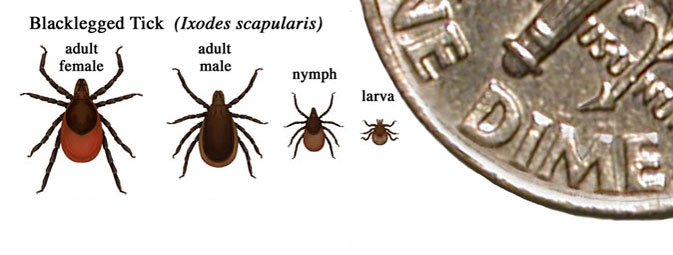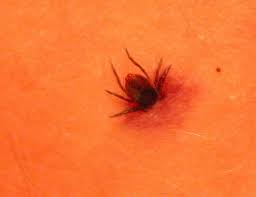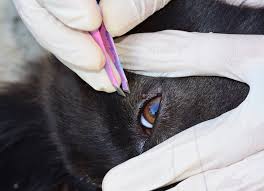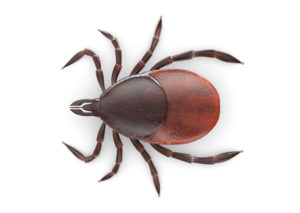
What is it?
Lyme disease is a bacterium that commonly infects woodland animals like mice or deer. Ticks pick up the bacteria by biting infected animals and then pass it on to their human hosts. There are many strains of Lyme disease just as there are many strains of the flu virus that cause flu symptoms in humans, with some strains more virulent than others.

Photo credit: CDC.gov
What does it do?
Common symptoms include:
- Developing a rash sometimes shaped like a “bull’s eye” mark.
- Initial flu-like symptoms such as fever, headache, nausea, jaw pain, light sensitivity, red eyes, muscle aches and neck stiffness.
While some Lyme victims experience immediate symptoms after infection, others may have none for many months.
Lyme disease does not get better without treatment and the longer it takes to diagnose, the harder it is.

Photo credit: health.gov.on.ca
How can I prevent it?
You want to spend time outdoors, be active; but remember to protect yourself against tick bites by taking these simple steps:
- Wear closed-toe shoes, long-sleeved shirts and pants
- Pull socks over pant legs to prevent ticks from crawling up legs
- Wear light-coloured clothes to spot ticks easier
- Use insect repellents that contain DEET (active ingredient to keep bugs away) or Icaridin. Insect repellents can be applied to clothing as well as exposed skin. Always read and follow label directions.
- Shower or bathe within two hours of being outdoors to wash away loose ticks
- Do a daily “full body” check for ticks on yourself, children and pets (Health Canada Registration – before insect repellants can be sold to the public, Health Canada conducts a risk assessment to ensure the product is safe and effective when used according to label directions.)
Where are the ticks?

Photo credit: https://www.canada.ca/en/public-health/services/diseases/lyme-disease/risk-lyme-disease.html
What do I do if I find a tick?
Take a picture of the tick with your phone – not every kind of tick and not every tick carries Lyme disease.
If you feel you must remove the tick yourself, follow these steps to remove it:

Photo credit: ucdavis.edu
- Using clean tweezers, carefully grasp the tick as close to the skin as possible. Pull slowly upward, but try not to twist or crush the tick.
- Once the tick is removed, wash the area where you were bitten with soap and water. You may also disinfect the area with alcohol or hand sanitizer. Wash your hands with soap and water.
If parts of the tick’s mouth break off and remain in your skin, remove them with tweezers. Visit your health care provider if you cannot remove:
- parts of the tick’s mouth in your skin
- the tick itself because it has buried itself deep into your skin
Go see your doctor or local healthcare professional as soon as possible.
Throw the tick into a zip lock bag or a small sealable bottle (like a pill bottle).
If you develop symptoms of Lyme disease after being bitten, contact your health care provider right away. Tell them:
- how long the tick was attached to you
- where you were when you were bitten by the tick
If you develop a rash, take a picture of the rash, as it may disappear or reduce before you can see your doctor.
But Prevention is the Key
There remains a great deal of controversy around testing and diagnosis. Some doctors are reluctant to test as they do not believe that current tests are reliable. But keep in mind two important things:
- Testing long after the bite may not detect the infecting bacterium; so if you suspect you, or a family member were bitten, get the blood test as soon as possible.
- Lyme disease has been chronically misdiagnosed; so if you believe that you or a family member are infected, you must be prepared to be aggressive in seeking treatment.
I found a tick on my dog
If you find a tick on your dog, don’t panic! Follow these quick and easy steps to safely remove the pest.
- Step 1: Get your gear
- Step 2: Remove the tick
- Step 3: Store the evidence
- Step 4: Praise your patient
- Follow up

Photo credit: petmd.com
Step 1: Get your gear
- Pair of gloves
- Clean pair of tweezers or a commercial tick remover
- Antiseptic
- Isopropyl alcohol

Photo credit: petmd.com
Step 2: Remove the tick
Wear gloves while removing the tick to avoid contact with your skin (ticks can transmit diseases to people, too).

photo credit Raid.ca
Step 3: Store the evidence
Drop the tick into a small container that contains isopropyl alcohol (the alcohol will quickly kill the tick), and mark the date on the container. If your dog begins displaying symptoms of a tick-borne illness, your veterinarian may want to identify or test the tick.
Step 4: Praise your patient
Clean your dog’s skin with antiseptic and make sure to clean your tweezers with isopropyl alcohol. Wash your hands, too! Then give your pup a treat for being a trooper.
Follow up
Keep an eye on the area where the tick was to see if an infection surfaces. If the skin remains irritated or infected, make an appointment with your veterinarian.
Watch your dog for symptoms of tick-borne diseases. Some symptoms include arthritis or lameness that lasts for three to four days, reluctance to move, swollen joints, fever, fatigue, swollen lymph nodes, loss of appetite and neurological problems.
